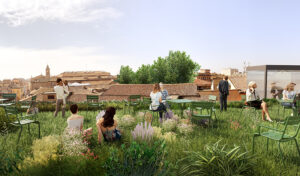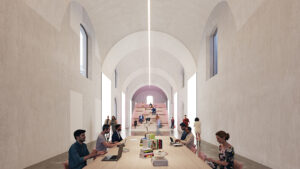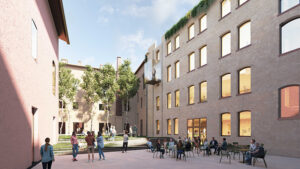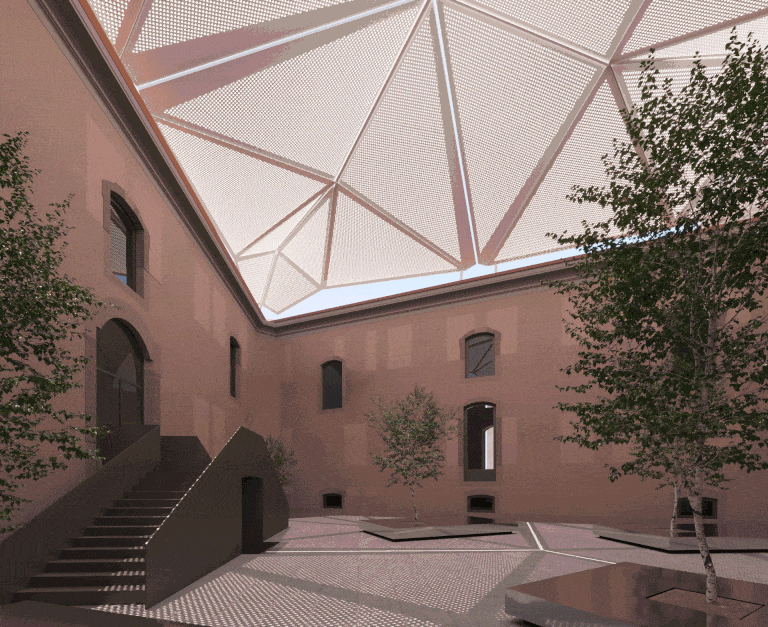In Modena, Italy, architects Carlo Ratti and Italo Rota have turned an 18th-century hospital complex into a multi-disciplinary cultural hub.
The master plan for AGO Modena Fabbriche Culturali features a kinetic roof designed with artist-engineer Chuck Hoberman, part of a broader, progressive vision for the restoration of historical buildings.
 “Cultural places should be thought of as dynamic, capable of incorporating change over time,” says Carlo Ratti, founding partner of CRA and director of the MIT Senseable City Lab.
“Cultural places should be thought of as dynamic, capable of incorporating change over time,” says Carlo Ratti, founding partner of CRA and director of the MIT Senseable City Lab.
“The changing nature of the built environment enables, in turn, a participatory approach to activate cultural production. AGO’s architecture sets up flexible, reconfigurable spaces where past and future complement each other,” he added.
CRA-Carlo Ratti Associati and Italo Rota sought to transforma venerable former hospital complex in Modena into one of the country’s major cultural and innovation hubs.
The design features a triangular-shaped plaza topped with an origami-like movable roof, conceived of by CRA and artist-engineer Chuck Hoberman.
 The master plan for the new hub, called AGO Modena Fabbriche Culturali, proposes a novel approach to the restoration of cultural heritage that grants it the flexibility to adapt to changing future configurations.
The master plan for the new hub, called AGO Modena Fabbriche Culturali, proposes a novel approach to the restoration of cultural heritage that grants it the flexibility to adapt to changing future configurations.
Measuring 20,000 square meters (210,000 square feet), the project by CRA and Italo Rota pursues an experimental design approach, matching the practices of architectural conservation with the transformative qualities of kinetic architecture, which is normally employed in temporary installations.
This is best characterized by one of AGO’s main courtyards, where a kinetic roof creates a multitude of spatial experiences. Lightweight and foldable, it opens and closes easily like origami, transforming this long-neglected courtyard into a social space adaptable to various climatic conditions and functions.
 Apart from that, photovoltaic panels will be installed to help harvest solar energy to power the complex.
Apart from that, photovoltaic panels will be installed to help harvest solar energy to power the complex.
The roof is a co-creation between CRA and Hoberman, one of the world’s leading experts in dynamic structure design and a former collaborator with NASA, the American space agency.
This is best characterized by one of AGO’s main courtyards, where a kinetic roof creates a multitude of spatial experiences.
Lightweight and foldable, it opens and closes easily like origami, transforming this long-neglected courtyard into a social space adaptable to various climatic conditions and functions.
Photovoltaic panels will also be installed on the new structure to harvest solar energy to help power the complex.
The roof is a co-creation between CRA and Hoberman, one of the world’s leading experts in dynamic structure design and a former collaborator with NASA, the American space agency.
Historical and contemporary elements are also present in other parts of the complex. Through the impressive “Tenaglie” corridors – whose name derives from their distinctive pincer-like vaults – visitors arrive at the chimney courtyard. Here, another kinetic installation leads people to a new rooftop terrace, now transformed into a garden where one can enjoy a bird’s eye view of Modena’s old house roofs and church domes.
“When we took a close look at AGO’s past, we discovered a panoply of histories, characters, and functions,” architect Italo Rota says.
“Because the complex had so many pasts, we thought our design should allow it to embody a multiplicity of futures. AGO Modena is the perfect embodiment of this approach as it brings together museums, training and co-working space under the same roof,” he concluded.
The AGO site is situated at the entrance to Modena’s medieval city center, whose monuments are part of the UNESCO World Heritage list.
The immense complex was built in the mid-18th century, with a sense of simplicity that hints at its function as the local Sant’Agostino Hospital. A previous, unrealized restoration was developed by architect Gae Aulenti in 2012.
When completed, AGO Modena will become a location that unites various institutions in visual arts, digital culture and educational experimentation.
Established by the City of Modena, Fondazione di Modena and the University of Modena and Reggio Emilia, AGO will host numerous entities across many disciplines, including the Modena Visual Arts Foundation, the Museo della Figurina (dedicated to collectible cards), and the Interdepartmental Research Center on Digital Humanities.
Imagee courtesy of Carlo Ratti Associati.

